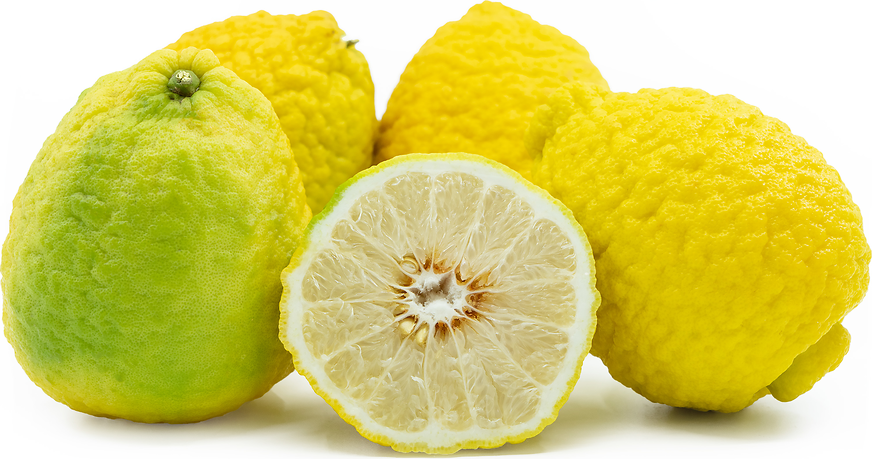


Papeda Citrus
Inventory, lb : 0
Description/Taste
Papeda citrus widely ranges in size, shape, and appearance, depending on the specific type, and is generally round, oval, to oblong in shape, averaging 2 to 10 centimeters in diameter. The rind is thick, semi-rough, and leathery, varying in shades of bright yellow, pale yellow, and green, and is often covered in prominent bumps and protrusions. Underneath the surface, there is a layer of white, bitter pith, encasing pale yellow segmented flesh that is divided by thin membranes. Papeda citrus is also filled with many cream-colored seeds embedded into the dry and pithy flesh, and the pulp vesicles contain concentrated, sharply flavored essential oils. Papeda citrus is aromatic with a fragrant, lemon-like scent, and the fruits bear a tart, sour, acidic, and semi-bitter flavor, creating an often unpalatable taste.
Seasons/Availability
Papeda citrus is available year-round.
Current Facts
Papeda citrus is a general descriptor used to encompass many primitive forms of citrus within the Rutaceae family. The ancient fruits are native to regions of tropical Asia, China, and Japan and are commonly referred to as a subgenus of the Citrus genus, but the classification of the fruits is highly disputed among experts. There are over fifteen known species, subspecies, and hybrid species within Papeda citrus, including Thai lime, yuzu, kabosu, ichang, alemow, kalpi, yuko, khasi, and sudachi, and many of these citruses occur in the wild along with numerous fruits that have not been well documented. Papeda citrus is slow-growing, hardy shrubs or small trees that generally produce sour, acidic, and bitter, unpalatable fruits. Historically, Papeda citrus is used among breeders as rootstock for commercial varieties to improve frost and disease resistance. Some types of Papeda citrus are also cultivated on a small scale worldwide and are used as an ornamental landscape plant, flavoring agent, and scent for perfumes, cosmetics, and body care products.
Nutritional Value
Papeda citrus, though not commonly consumed, is a source of vitamins A and C, nutrients that strengthen the immune system and reduce inflammation. The fruits may also contain some potassium to balance fluid levels within the body, calcium to protect overall bone health, and iron to build the protein hemoglobin for oxygen transport through the bloodstream. Various types of Papeda citrus are incorporated into natural medicines to relieve symptoms associated with common colds and digestive issues throughout Asia. Citrus peels are often used in Traditional Chinese Medicine to relieve respiratory ailments, stimulate natural digestion, and maintain liver health.
Applications
Papeda citrus is traditionally used fresh as a tart, acidic flavoring in raw and cooked preparations. The juice and zest are the most-used components of the fruit in culinary applications, as the flesh tends to be fibrous, acrid, and dry, creating an unpleasant mouthfeel. Papeda citrus juice can provide a bright, tangy flavor to sauces, marinades, dressings, and vinegar and can sometimes be used as a substitute for lemons in recipes. The juice can be squeezed over miso, dumpling, and noodle soups for a splash of acidity, or it can be used to compliment fresh flavors of sushi, sashimi, and ceviche. The juice can also be incorporated into cabbage salads, noodle and rice dishes, or stirred into sparkling beverages, cocktails, and tea. Beyond the juice, Papeda citrus is used for its fragrant rind, and the skin can be zested over hot pot, vegetable dishes, and roasted meats for a bright flavor. Papeda citrus zest can also be incorporated into cakes, tarts, and pies or blended into ice cream, sorbet, and custards. In addition to zesting, the peel can be dried and used for teas or ground into a powder for extended use. The leaves of some Papeda citrus are also used as a flavoring in regionally specific cuisine throughout Asia. Papeda citrus pairs well with herbs such as coriander, basil, and mint, mushrooms, ginger, green tea, fruits such as nectarines, raspberries, pomegranates, and peaches, eggs, tofu, seafood including fish, scallops, crab, and shrimp, and meats such as poultry, steak, and pork. Whole, unwashed Papeda citrus will keep 1 to 4 weeks when stored lightly wrapped in the refrigerator's crisper drawer.
Ethnic/Cultural Info
In Oceania, Papeda citrus is frequently added to shampoos as a clarifying remedy to nourish the scalp, reduce oil, treat dandruff, and cleanse hair from product buildup to improve texture and shine. The citrus juice can also be incorporated into skin cleansers and is believed to help develop an even skin complexion. In addition to the juice, Papeda citrus contains aromatic essential oils that are extracted and mixed with coconut oil as a fragrant body moisturizer. The oils are also commonly incorporated into perfumes or other cosmetic products for their lingering, pleasant citrus scent. In Japan, Papeda citrus is sliced and tossed into hot baths during the winter season to boost immunity and ward off various colds and flu.
Geography/History
Papeda citrus is a grouping of ancient fruits native to tropical Asia, China, and Japan that have been growing wild for thousands of years. There are many different types of Papeda citrus, and each type is difficult to trace historically as the fruits easily cross-pollinate in the wild, constantly developing new and closely related fruits. A unique trait of Papeda citrus is their frost tolerance. Despite the fruits being native to warm, tropical, and humid regions, the fruits display a stronger resistance to frost than many other citrus varieties found worldwide, allowing them to be grown in temperate regions and be used for rootstock. Today, Papeda citrus is not commercially grown on a wide scale and is considered the least cultivated subgenus of citrus. The fruits are mostly found growing wild and occur in many parts of Asia, Southeast Asia, and Oceania. In markets worldwide, different species of Papeda citrus will be more readily available than other types. Papeda citrus is primarily sold through specialty grocers and local fresh markets.
Recipe Ideas
Recipes that include Papeda Citrus. One
| Still Clumsy with Chopsticks |
|
Sudachi (Papeda) Infused Liquor |








